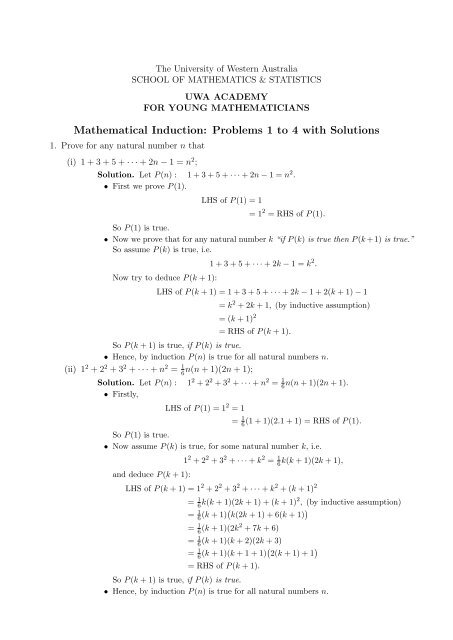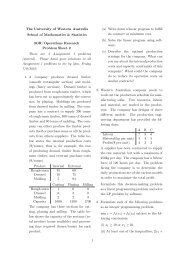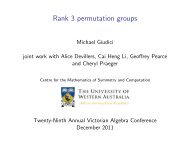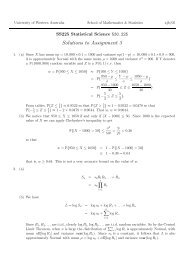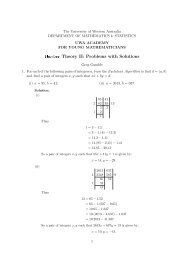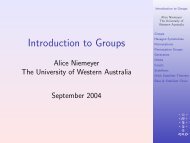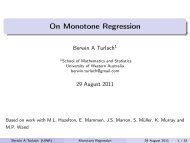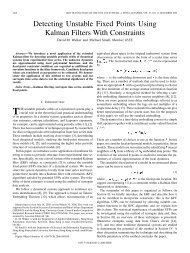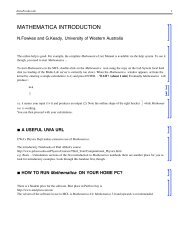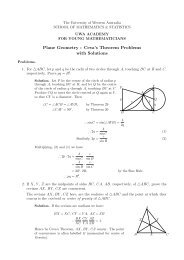Mathematical Induction: Problems with Solutions - The University of ...
Mathematical Induction: Problems with Solutions - The University of ...
Mathematical Induction: Problems with Solutions - The University of ...
You also want an ePaper? Increase the reach of your titles
YUMPU automatically turns print PDFs into web optimized ePapers that Google loves.
<strong>The</strong> <strong>University</strong> <strong>of</strong> Western AustraliaSCHOOL OF MATHEMATICS & STATISTICSUWA ACADEMYFOR YOUNG MATHEMATICIANS<strong>Mathematical</strong> <strong>Induction</strong>: <strong>Problems</strong> 1 to 4 <strong>with</strong> <strong>Solutions</strong>1. Prove for any natural number n that(i) 1 + 3 + 5 + · · · + 2n − 1 = n 2 ;Solution. Let P (n) : 1 + 3 + 5 + · · · + 2n − 1 = n 2 .• First we prove P (1).LHS <strong>of</strong> P (1) = 1= 1 2 = RHS <strong>of</strong> P (1).So P (1) is true.• Now we prove that for any natural number k “if P (k) is true then P (k + 1) is true.”So assume P (k) is true, i.e.Now try to deduce P (k + 1):1 + 3 + 5 + · · · + 2k − 1 = k 2 .LHS <strong>of</strong> P (k + 1) = 1 + 3 + 5 + · · · + 2k − 1 + 2(k + 1) − 1= k 2 + 2k + 1, (by inductive assumption)= (k + 1) 2= RHS <strong>of</strong> P (k + 1).So P (k + 1) is true, if P (k) is true.• Hence, by induction P (n) is true for all natural numbers n.(ii) 1 2 + 2 2 + 3 2 + · · · + n 2 = 1 n(n + 1)(2n + 1);6Solution. Let P (n) : 1 2 + 2 2 + 3 2 + · · · + n 2 = 1 6n(n + 1)(2n + 1).• Firstly,LHS <strong>of</strong> P (1) = 1 2 = 1= 1 6(1 + 1)(2.1 + 1) = RHS <strong>of</strong> P (1).So P (1) is true.• Now assume P (k) is true, for some natural number k, i.e.and deduce P (k + 1):1 2 + 2 2 + 3 2 + · · · + k 2 = 1 6k(k + 1)(2k + 1),LHS <strong>of</strong> P (k + 1) = 1 2 + 2 2 + 3 2 + · · · + k 2 + (k + 1) 2= 1 6 k(k + 1)(2k + 1) + (k + 1)2 , (by inductive assumption)= 1 6 (k + 1)( k(2k + 1) + 6(k + 1) )= 1 6 (k + 1)(2k2 + 7k + 6)= 1 6(k + 1)(k + 2)(2k + 3)= 1 6 (k + 1)(k + 1 + 1)( 2(k + 1) + 1 )= RHS <strong>of</strong> P (k + 1).So P (k + 1) is true, if P (k) is true.• Hence, by induction P (n) is true for all natural numbers n.
(iii) 1 3 + 2 3 + 3 3 + · · · + n 3 = 1 4 n2 (n + 1) 2 ;Solution. Let P (n) : 1 3 + 2 3 + 3 3 + · · · + n 3 = 1 4 n2 (n + 1) 2 .• Firstly,LHS <strong>of</strong> P (1) = 1 3 = 1= 1 4 .12 (1 + 1) 2 = RHS <strong>of</strong> P (1).So P (1) is true.• Now assume P (k) is true, for some natural number k, i.e.and deduce P (k + 1):1 3 + 2 3 + 3 3 + · · · + k 3 = 1 4 k2 (k + 1) 2 .LHS <strong>of</strong> P (k + 1) = 1 3 + 2 3 + 3 3 + · · · + k 3 + (k + 1) 3= 1 4 k2 (k + 1) 2 + (k + 1) 3 , (by inductive assumption)= 1 4 (k + 1)2( k 2 + 4(k + 1) )= 1 4 (k + 1)2 (k 2 + 4k + 4)= 1 4 (k + 1)2 (k + 2) 2= 1 4 (k + 1)2 (k + 1 + 1) 2= RHS <strong>of</strong> P (k + 1).So P (k + 1) is true, if P (k) is true.• Hence, by induction P (n) is true for all natural numbers n.(iv) 1 2 + 4 2 + 7 2 + · · · + (3n − 2) 2 = 1 2 n(6n2 − 3n − 1);Solution. Let P (n) : 1 2 + 4 2 + 7 2 + · · · + (3n − 2) 2 = 1 2 n(6n2 − 3n − 1);• Firstly,LHS <strong>of</strong> P (1) = 1 2 = 1= 1 2 .1(6.12 − 3.1 − 1) = RHS <strong>of</strong> P (1).So P (1) is true.• Now assume P (k) is true, for some natural number k, i.e.and deduce P (k + 1):1 2 + 4 2 + 7 2 + · · · + (3k − 2) 2 = 1 2 k(6k2 − 3k − 1)LHS <strong>of</strong> P (k + 1) = 1 2 + 4 2 + 7 2 + · · · + (3k − 2) 2 + ( 3(k + 1) − 2 ) 2= 1 2 k(6k2 − 3k − 1) + 9k 2 + 6k + 1 (by inductive assumption)= 1 2 (6k3 − 3k 2 − k + 18k 2 + 12k + 2)= 1 2 (6k3 + 15k 2 + 11k + 2)= 1 2 (k + 1)(6k2 + 9k + 2)= 1 2 (k + 1)( 6(k + 1) 2 − 12k − 6 + 9k + 2 )= 1 2 (k + 1)( 6(k + 1) 2 − 3k − 4 )= 1 2 (k + 1)( 6(k + 1) 2 − 3(k + 1) − 1 )= RHS <strong>of</strong> P (k + 1).So P (k + 1) is true, if P (k) is true.• Hence, by induction P (n) is true for all natural numbers n.2
(v) 2 2 + 5 2 + 8 2 + · · · + (3n − 1) 2 = 1 2 n(6n2 + 3n − 1).Solution. Let P (n) : 2 2 + 5 2 + 8 2 + · · · + (3n − 1) 2 = 1 2 n(6n2 + 3n − 1).• Firstly,LHS <strong>of</strong> P (1) = 2 2 = 4= 1 2 .1(6.12 + 3.1 − 1) = RHS <strong>of</strong> P (1).So P (1) is true.• Now assume P (k) is true, for some natural number k, i.e.2 2 + 5 2 + 8 2 + · · · + (3k − 1) 2 = 1 2 k(6k2 + 3k − 1)and deduce P (k + 1). We could follow an approach similar to the previous exercise;instead, we will demonstrate another technique: that <strong>of</strong> expanding an expression ink in powers <strong>of</strong> k + 1 by replacing k by k + 1 − 1.LHS <strong>of</strong> P (k + 1) = 2 2 + 5 2 + 8 2 + · · · + (3k − 1) 2 + ( 3(k + 1) − 1 ) 2= 1 2 k(6k2 + 3k − 1) + 9(k + 1) 2 − 6(k + 1) + 1, (by inductive assumption)= 1 2 k( 3k(2k + 1) − 1 ) + 9(k + 1) 2 − 6(k + 1) + 1= 1 2(3 k ( (k + 1) − 1 )( 2(k + 1) − 1 ) )− 1 + 9(k + 1) 2 − 6(k + 1) + 1= 1 2(3 k ( 2(k + 1) 2 − 3(k + 1) + 1 ) )− 1 + 9(k + 1) 2 − 6(k + 1) + 1= 1 )(2((k + 1) − 1 6(k + 1) 2 − 9(k + 1) + 2 ) + 1 (2 18(k + 1) 2 − 12(k + 1) + 2 )((k + 1) ( 6(k + 1) 2 − 9(k + 1) + 2 )= 1 2= 1 2− ( 6(k + 1) 2 − 9(k + 1) + 2 )+ (k + 1) ( 18(k + 1) − 12 ) )+ 2((k + 1) ( 6(k + 1) 2 − 9(k + 1) + 2 )− (k + 1) ( 6(k + 1) − 9 ) − 2+ (k + 1) ( 18(k + 1) − 12 ) )+ 2= 1 2 (k + 1) (6(k + 1) 2 − 9(k + 1) + 2− 6(k + 1) + 9)−18(k + 1) − 12= 1 2 (k + 1)( 6(k + 1) 2 + 3(k + 1) − 1 )= RHS <strong>of</strong> P (k + 1).So P (k + 1) is true, if P (k) is true.• Hence, by induction P (n) is true for all natural numbers n.(vi) 1 · 3 + 2 · 4 + · · · + n · (n + 2) = 1 n(n + 1)(2n + 7).6Solution. Let P (n) : 1 · 3 + 2 · 4 + · · · + n · (n + 2) = 1 6n(n + 1)(2n + 7).• Firstly,LHS <strong>of</strong> P (1) = 1 · 3 = 3= 1 6 · 1 · 2 · 9= 1 6· 1(1 + 1)(2 · 1 + 7) = RHS <strong>of</strong> P (1).3
So P (1) is true.• Now assume P (k) is true, for some natural number k, i.e.and deduce P (k + 1):1 · 3 + 2 · 4 + · · · + k · (k + 2) = 1 k(k + 1)(2k + 7).6LHS <strong>of</strong> P (k + 1) = 1 · 3 + 2 · 4 + · · · + k · (k + 2) + (k + 1) · (k + 1 + 2)= ( LHS <strong>of</strong> P (k) ) + (k + 1)(k + 3)= ( RHS <strong>of</strong> P (k) ) + (k + 1)(k + 3), (by inductive assumption)= 1 6k(k + 1)(2k + 7) + (k + 1)(k + 3)= 1 6 (k + 1)( k(2k + 7) + 6(k + 3) )= 1 6 (k + 1)(2k2 + 13k + 18)= 1 6(k + 1)(k + 2)(2k + 9)= 1 5 (k + 1)(k + 1 + 1)( 2(k + 1) + 7 )= RHS <strong>of</strong> P (k + 1).So P (k + 1) is true, if P (k) is true.• Hence, by induction P (n) is true for all natural numbers n.2. Prove that for any natural number n,2( √ n + 1 − 1) < 1 + 1 √2+ · · · + 1 √ n< 2 √ n.Solution. Let P (n) : 2( √ n + 1 − 1) < 1 + 1 √2+ · · · + 1 √ n< 2 √ n. Now P (n) should bethought <strong>of</strong> as two simultaneous inequalities, namely:where(M is mnemonic for “middle”.)• Firstly,andLHS(n) < M(n) and M(n) < RHS(n),LHS(n) := 2( √ n + 1 − 1),M(n) := 1 + 1 √2+ · · · + 1 √ nandRHS(n) := 2 √ n.LHS(1) = 2( √ 2 − 1) = 2(√ 2 − 1)( √ 2 + 1)√2 + 1=M(1) = 1 < 2 = 2 √ 1 = RHS(1).So P (1) is true.• Now assume P (k) is true, for some natural number k, i.e.M(k) > LHS(k) and M(k) < RHS(k),2√ < 22 + 1 1 + 1 = 1 = M(1),4
and deduce P (k + 1):M(k + 1) = 1 + √ 1 + · · · + 1 1√ + √2 k k + 11= M(k) + √k + 11> LHS(k) + √ , (by inductive assumption)k + 1= 2( √ k + 1 − 1) +1√k + 1= 2( √ k + 2 − 1) − 2( √ k + 2 − √ k + 1) +1√k + 1= 2( √ k + 2 − 1) − 2(√ k + 2 − √ k + 1)( √ k + 2 + √ k + 1) 1√ √ + √k + 2 + k + 1 k + 1= 2( √ k + 2 − 1) −> 2( √ k + 2 − 1) −= 2( √ k + 2 − 1) −Also . . . M(k + 1) = 1 + 1 √2+ · · · + 1 √k+= M(k) +< RHS(k) += 2 √ k +1√k + 12√k + 2 +√k + 1+2√k + 1 +√k + 1+1√k + 11√k + 122 √ k + 1 + 1√k + 1= 2( √ k + 2 − 1) = LHS(k + 1),1√k + 11√k + 1, (by inductive assumption)1√k + 1= 2 √ k + 1 − 2( √ k + 1 − √ k) +1√k + 1= 2 √ k + 1 − 2(√ k + 1 − √ k)( √ k + 1 + √ k) 1√ √ + √k + 1 + k k + 1= 2 √ k + 1 −< 2 √ k + 1 −2√k + 1 +√k+1√k + 12√k + 1 +√k + 1+1√k + 1= 2 √ 2k + 1 −2 √ k + 1 + 1√ = 2 √ k + 1 = RHS(k + 1).k + 1i.e. M(k + 1) > M(k + 1) and M(k + 1) > RHS(k + 1).So P (k + 1) is true, if P (k) is true.• Hence, by induction P (n) is true for all natural numbers n.5
3. Prove 3 n > 2 n for all natural numbers n.Solution. Let P (n) : 3 n > 2 n .• Firstly,LHS <strong>of</strong> P (1) = 3 1 = 3> 2 = 2 1 = RHS <strong>of</strong> P (1).So P (1) is true.• Now assume P (k) is true, for some natural number k, i.e.and deduce P (k + 1):3 k > 2 kLHS <strong>of</strong> P (k + 1) = 3 k+1= 3 k .3> 2 k .3, (by inductive assumption)> 2 k .2= 2 k+1= RHS <strong>of</strong> P (k + 1).i.e. LHS <strong>of</strong> P (k + 1) > RHS <strong>of</strong> P (k + 1).So P (k + 1) is true, if P (k) is true.• Hence, by induction 3 n > 2 n for all natural numbers n.4. Prove Bernouilli’s Inequality which states:If x ≥ −1 then (1 + x) n ≥ 1 + nx for all natural numbers n.Solution. Let P (n) : (1 + x) n ≥ 1 + nx, if x ≥ −1.• Firstly,LHS <strong>of</strong> P (1) = (1 + x) 1 = 1 + x= 1 + 1.x = RHS <strong>of</strong> P (1).So P (1) is true.• Now assume P (k) is true, for some natural number k, i.e.and deduce P (k + 1):LHS <strong>of</strong> P (k + 1) = (1 + x) k+1= (1 + x) k .(1 + x)(1 + x) k ≥ 1 + kx, if x ≥ −1= ( LHS <strong>of</strong> P (k) ) .(1 + x)≥ ( RHS <strong>of</strong> P (k) ) .(1 + x), (by inductive assumption. . . 1 + x ≥ 0 since x ≥ −1)= (1 + kx)(1 + x)= 1 + (k + 1)x + kx 2≥ 1 + (k + 1)x, (since k > 0, x 2 ≥ 0, so that kx 2 ≥ 0)= RHS <strong>of</strong> P (k + 1).So P (k + 1) is true, if P (k) is true.• Hence, by induction P (n) is true for all natural numbers n.6


